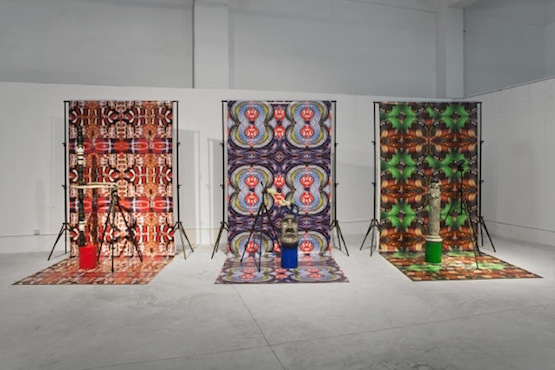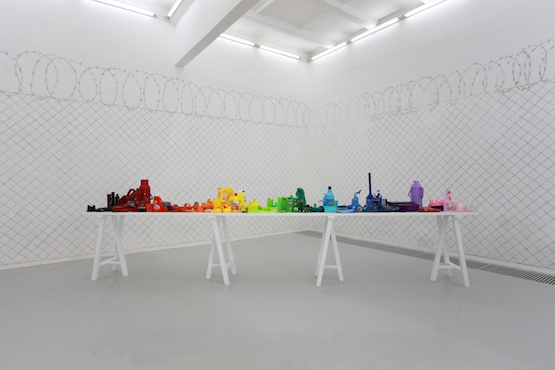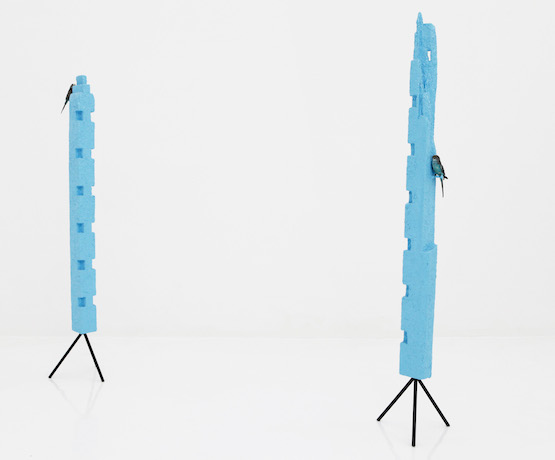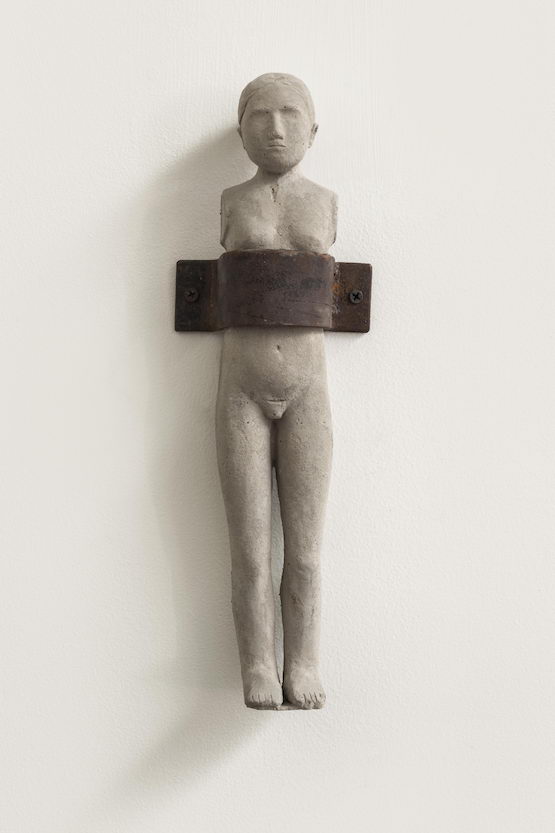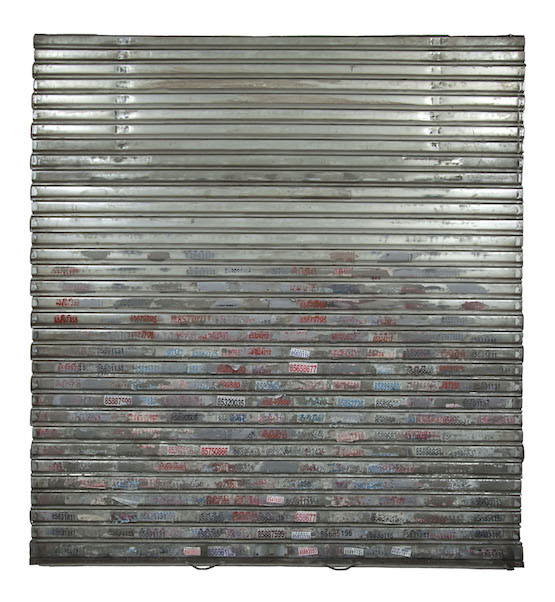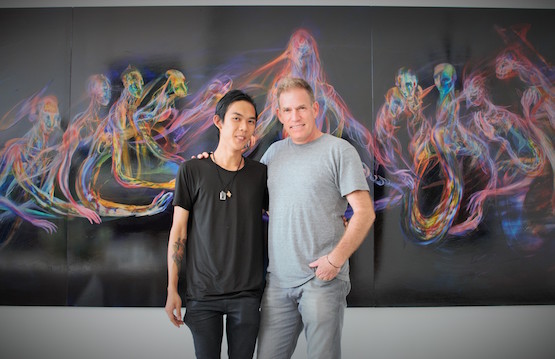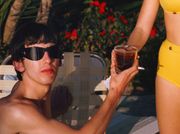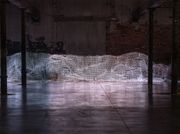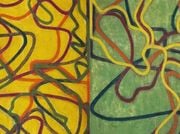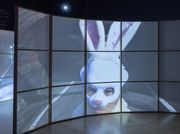Serge Tiroche
Serge Tiroche with work by Ruben Pang. Photo: Laura Di Castro
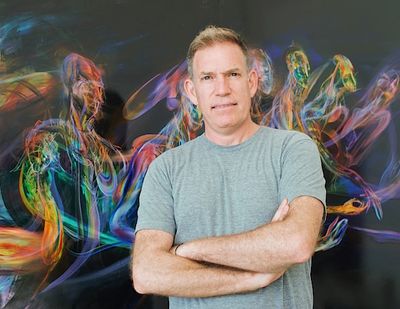
Serge Tiroche with work by Ruben Pang. Photo: Laura Di Castro
With an ultra slick website that enables easy navigation of its 400 plus artworks from many of the leading artists of today, the Tiroche DeLeon Collection is unique in its focus and ownership structure. Established in 2011 by Serge Tiroche and Russ DeLeon, the collection is focused on artworks by both recognised masters, and emerging talent from the new markets of contemporary art: Asia, Africa, the Middle East, and Latin America.
In March 2012, DeLeon and Tiroche transferred 230 works in the collection to an investor fund, and thus the first art investment fund modeled on a private collection was born.
Serge Tiroche was born in Israel in 1966 and grew up with art. His father was a well-known art dealer and his mother a painter. He left a career in finance in 2008 to pursue his passion for art, and founded START, an artist incubator project, and Serge Tiroche Consultants, a financial services consultancy with a focus on art. In 2009-2010 he was Chairman of Artist Pension Trust and in 2011 co-founded Art Vantage Ltd, owner of the Tiroche DeLeon Collection. In 2015 he co-founded ArtRunners, a start-up aimed at revolutionising the art logistics industry.
He currently serves on the Board of Governors of the Tel-Aviv Museum, the 'Here & Now' committee of the Israel Museum, and is a Council member of the Serpentine Gallery in London. Anna Dickie took the opportunity to discuss the Tiroche DeLeon Collection with Serge Tiroche.
ADI know your father was a collector and a dealer, but when did your own personal obsession with collecting art start?
STI made my first acquisitions when I was a student in Paris, in the late eighties, and those purchases were mostly for investment purposes. I would go with my brother and father to auctions or flea markets, and I would buy ten per cent of a painting, with the little money I had, and then pay it off. I was just trading in art, learning the ins and outs of the industry. I started collecting for my own private collection of contemporary art in 1992, in Israel.
ADCan you remember the first piece?
STYes. It was a painting by an Israeli artist, Tsibi Geva. Funny how many years it has been since I bought that. It has been 23 years. He is representing Israel in the Venice Biennial this year.
ADYou caught him early.
STYes [laughs]. I still have the work hanging in my home.
ADWhen you look back at that time and think about what art you liked then, and compare it to what you like now—what has changed?
STI would still like that painting today. But it's kind of unique. There are other works that I don't like as much today. Initially—and I think a lot of people go through this—people are attracted to hyperrealism and photographic works, but as time goes by you look for more depth, more sophistication, more abstract work. You evolve: it's a natural thing.
ADLet's talk first about the Tiroche DeLeon Collection. It has an unusual ownership structure. Can you please explain it?
STArt Vantage is the legal entity that owns the Collection. Initially we were the only two shareholders, now we are eight and a ninth will join us in September.
It all started when Russ came to me one day, after I had been advising his family office for 3 years, and said he wanted to start collecting. We quickly booked a trip to India together in January 2011, during the India Art Fair, and started buying for our common collection. Soon we agreed on a $10 million starting budget, agreed to focus on contemporary from developing markets, for several reasons: personal interest, freshness of artworks, attractive prices, macro-economic backdrop, nascent art scene, differentiation from other art funds, etc ... etc ... We also figured that we could have a significant impact on the art scene in those markets and play a greater role in supporting their art ecosystems. In the western markets we would just be another drop in the ocean. Fifteen months later I had invested the ten million dollars.
People started asking us how they could also participate and so we converted the original investment into what is called an "experienced investment fund". And more investors started joining us.
ADUsually for an investment fund, there are limits relating to the scope of investment permitted. Is there criteria for the type of artist or artworks the fund invests in (outside of being relevant to the emerging markets in developing countries)?
STWhat I look for when adding an artist's work to the collection is whether there is some local content in their work, be it via the materials they use, the subject of the work or the unique way in which it is made.
I am looking for that something special; I am looking to see a work that is original and brings something new to what I have seen before. I also am looking for something that speaks a very contemporary language, but also indicates a quality of craftsmanship.
And when you start to think about investment, you also have to think about whether the work can be sold in the future: is this artist well supported by good galleries, good collectors, good curators? Does the artist have sufficient residencies, prizes, media coverage? You have to look at a lot of things. What I do look for particularly is artists who are already making a name in the local market, but haven't really been discovered internationally; I want to buy them before they do Venice, and or Documenta and before they are given major solo exhibitions in important museums. I am proud to say we have a pretty good track record at doing just that already!
ADHow do you approach the sale of works from the collection?
STThe dream is that a big museum in China or somewhere else decides they want to buy the entire collection, and they have the budget to do it—then the collection can continue to live. It has become a much more important element of consideration for me because I think we've built a collection of art historic value.
ADDoes that mean at the moment you are holding all the works you buy?
STWe do hold most of the works we buy, but we have sold 20 or so works. We have 420 though. The reason for those sales is that when I discover a new artist, I might buy five or six pieces, and then if prices evolve, I want to have the opportunity to buy more, and I don't want to be over-exposed to any one artist, so to make room for new works by that artist, I have to sell some of the works I have. Sometimes I sell art so I have the opportunity to buy something else. I am a market person as well; when I see opportunities I like to take then. You have to be savvy. But the bulk of the collection is to be held all the way to the end.
ADWhere do you keep the works?
STMany of the works are on loan; we loan the works for exhibitions and also generally to museums, and some investors have them in their homes.
ADI saw one work in the exhibition, Inside China.
STYes we have five works here: including two works by Yu Ji, two by Li Gang and the gate by Wu Hao.
ADWho are the artists at the moment you are particularly interested in?
STMagician Space is probably my favorite gallery in China at the moment. They represent several of the most interesting young artists in China. We acquired at least a couple of works by each of Yu Honglei, Guan Xiao, Timur Si Qin, Wu Hao and Li Jinghu. Then there's Leo Xu Projects in Shanghai, who also represents a group of other talented young artists, such as Cheng Ran, Liu Chuang and Ciu Jie.
ADWhat specific countries or areas are you focused on?
STAfrica is a big area for us now. There is a huge amount of interest in Africa at the moment. We are also very interested in artists from South East Asia, and of course we continue to be interested in China.
ADLatin America, Africa?
STLatin America is amazing; it's a very good market. We have already built up a very expansive collection of works from there, and we are just enjoying the ride now as the market expands. And now we just occasionally add an exceptional work here or there.
In terms of India, we also have an expansive collection. I started buying works from India, and then I went on to focus Latin America. China—I have buying from there gradually and steadily all along.
Africa is a more recent focus area even though we acquired our first El Anatsui in January 2011 already. We were very pleased to be able to acquire 3 works of Pascale Marthine Tayou some time before his show at the Serpentine Gallery. Adrian Villar Rojas is another artist we bought in 2011 already and has also had a major solo show at the Serpentine gallery, inaugurating the new Sackler Gallery there in October 2013.
ADBut for you, it isn't just about investment is it? You also have the 'START' project for young artists?
STYes. I founded START eight years ago. To really understand what I am trying to do you have to go back and see my career and the directions I have taken. The big picture is that I am really trying to bring the world of investment and the passion of art collecting closer together. Building a bridge that respects the etiquette of contemporary art collecting, supports the artists, and enables more people the opportunity to collect art. Collecting brings a lot of joy and interest into what is 'life'. It's about opening the door to people who want to get into the art world. What we are offering them is the ability to invest in a secure environment with an experienced person and offer them a library of works that they can pick and choose from to hang in their homes. And if they fall in love with something they have the ability to buy it, if they want to come with me to art fairs and learn the ins and outs of the market, they are welcome to do so. There are also on the other hand people interested in what we are doing, but don't invest; they can follow us if they wish by various means: subscribing to our quarterly newsletters, reading our rich content on the website featuring highlights on young artists, market commentary and lots more, or they can follow me on Instagram and Facebook.
ADYour website is very good. Why was it to important to you?
STThank you. We spent a lot of time on that. It is important because it is our business card and the main platform where most people see the work that we own. We are a collection, more than we are an art fund, and we want to share the art. That's a key differentiator for us: we are modeled on the best private collections, but we are a collective collection. The history of art funds isn't great and most of the models tried have failed. I think that is because the people behind them were only interested in the investment. The process didn't serve the bigger purpose. It wasn't helpful to the art world at all.
More and more people are sharing collections, and talking about art lending as a business model. I don't know if it will work. Transparency is key. We've seen many positions being abused in the art world. I think it's a lot better if people can see what you do, and the website is part of this. I think it's the model for the future: it serves our investors well, is good exposure for the artists we collect, and enables curators to consider artworks in our collection for exhibitions. It generally enables more people to be involved in our collection.
ADWhat art fairs do you try to focus on and get to?
STI don't go to fairs to buy art so much anymore; that's not the reason I go. I get artworks delivered to my laptop and mobile all year around, and I get all the previews of everything that way. I don't really need to go to the fairs. But I do go, because sometimes it's important to be present, meet the galleries, artists and other important art world personalities, face to face, shake hands, conclude deals, and occasionally discover new works in the booth or on the iPad. But discoveries at art fairs are getting fewer and fewer for me. Honestly, I do so many art fairs that I can sometimes get confused to the point that I am not sure which art fair I am at; it's often the same galleries.
The fairs are a great place for the local collector who doesn't have the time to shop for art all year round, which people like me do have. There are a few people like me in the art world, who take collecting very seriously; it's our job really. It's what we do. The wider audience, the public, doesn't experience that. They do one or two fairs a year and they love it; it's a great few days off from day-to-day activity.
ADWe have talked before about the fair being important to you in terms of networking and meeting people?
STIt is very much for me now about meeting other people in the industry, working on a few projects, meeting possible investors, having a couple of interviews, just general networking.
I do however often complete acquisitions when at an art fair. Sometimes I will have been negotiating about an artwork—the artwork might not even be at the fair—but the fair provides a good time to complete the negotiation.
At Basel in Hong Kong, for example, there was one transaction I did there in relation to an artist I have been following for a while. But I also met with other people, and in particular I met with Lisson Gallery to discuss one of their artists. That gallery is one of the best galleries. They take care of their artists and their clients, and it all feels like a family. I really like working with them. They could be one of those mega galleries, but they don't want to be.
ADIs there anything we haven't talked about which you would like to talk about?
STI would like to mention one thing we are doing: an artist residency program. We are inviting emerging artists from developing countries to come and stay at my private residence in Israel. Israel is a small country with beautiful scenery. It's culturally very interesting. My house is in an area that is Jewish, Muslim, and Christian. Ethnically it is also very interesting. Jerusalem is only 45 minutes away, and is a completely different experience. I think it will be interesting for artists to come and see the reality of Israel, and have the opportunity to perceive Israel in a very different way. Ruben Pang, our first artist in Residence, is just completing his three month stay and has painted an amazing body of work. The exhibition is fabulous and has received a lot of media coverage and collector interest. Most importantly, I can safely say it has been a very significant milestone in Ruben's development as an artist, and nothing makes me more proud.
ADTell me more about Ruben Pang?
STRuben Pang has an interesting story. We developed a whole curatorial concept for his residency. Ruben grew up in Singapore, and his father was a military person. His father had a very strong influence on Ruben as a child and they remain very close. His father was trained by the Israeli intelligence. There is a strong connection between Singapore and Israel. They are similar countries in terms of being small and surrounded by enemies.
Ruben was brought up as Christian, but his father later turned to spirituality, became a healer and an exorcist. So Ruben is very influenced by this. He paints portraits, but not of facial traits or physical persons, but of energies. He paints ghosts, spirits, apparitions, dreams. What I suggested to Ruben initially, was to follow the stories of Jesus and his disciples from the New Testament and paint his version of the scenes depicted therein, including his own version of The Last Supper. During the Residency Ruben's thinking broadened and he painted scenes from the Old Testament as well. It's powerful.
ADAre there also any plans for a physical space?
STNo! I don't like that idea. I don't think it makes a lot of economic sense if you can get the same brand recognition without the associated costs and the hassle involved. Also, we are not quite wealthy enough for that, we spend our money on the art. More importantly however, I prefer that the art travel to people, wherever they are, rather than people having to travel to visit a museum bearing my name, or showing my artworks.—[O]


